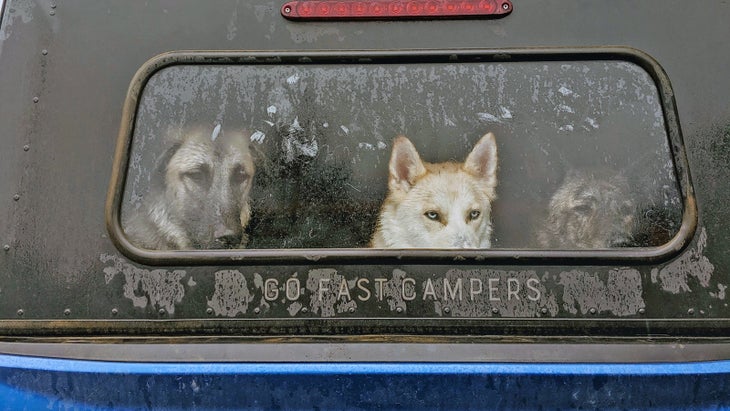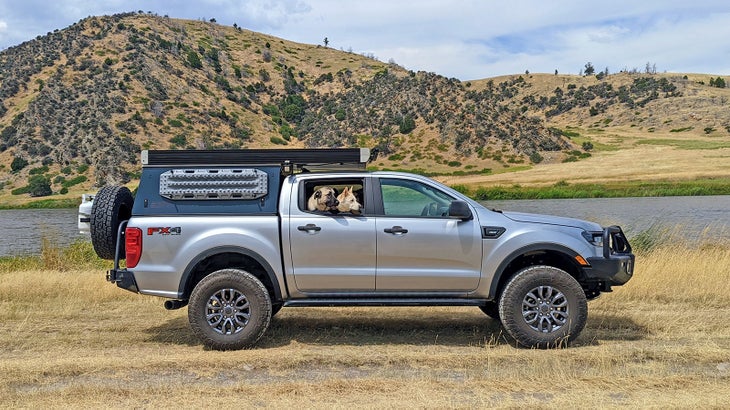Whether you think of it as the hottest summer you’ve ever experienced, or the coolest summer of the rest of your life, pretty much all of us are dealing with record breaking heat right now. That’s doubly challenging for dog owners, especially those of us that want to include our pups in summer activities.
Dogs Die in Hot Cars, and Trucks Too
Dogs begin to experience life-threatening heat stroke when their internal temperature reaches 105.8 degrees. There’s numerous variables, but in hot weather, a parked car can exceed that temperature in 10 minutes or less—even if the windows are down or it’s parked in the shade. This is a risk all dog owners and caretakers must constantly keep in mind. Never leave a dog inside a parked car, without the air-conditioning running, for even a brief period of time.
This same problem effects dogs traveling in pickup beds, whether they’re capped, wearing a camper, or left open. Unlike humans, dogs do not have the ability to sweat. They do not cool themselves evaporatively from their skin. So canines remain at risk of overheating through solar exposure if kept in a shade-free area, such as an open pickup bed. And, bed caps, toppers, or campers can also quickly reach unsafe temperatures.
An informal study conducted by GoFastCampers (GFC)—a Montana-based company that produces an ultralight truck bed camper, which clamps to a vehicle’s bed rails and houses four inches of insulation under a white roof to reflect solar radiation—found that though the covered bed area heated up slower, and to less severe temperatures when compared to the cab of the truck it was mounted to, it still reached unsafe degree levels when parked in the hot sun for extended periods.
Gunner Kennels, which makes high-end, ultra-safe dog crates, has found that the interior of those crates can run as cool as 15 degrees below ambient, even with direct sun exposure. But, right now, temperatures are well above safe levels for dogs across vast swaths of the country. And those temperatures can be even hotter in places we like to park our cars and trucks, like black parking lots, where asphalt captures and radiates heat. Even in 75 degree ambient temperatures, pavement can quickly reach 125 degrees when exposed to direct sun, and can project that heat upward six feet or more.
GFC did find that internal temperatures inside its campers and bed toppers quickly returned to ambient levels once the vehicle was in motion, with the side panels cracked to facilitate airflow. Don’t think of pickup bed caps, campers, or kennels as a solution to heat, but they may prove a helpful tool in reducing the heat exposure your dog faces.
There’s a plethora of wireless, battery powered thermometers that may help you monitor temperature inside a crate or pickup bed. But while they can prove a valuable tool, nothing beats you being there with your dog. (If you’re hot, they’re hotter.)

Heat Brings Other Risks to Traveling with a Dog
Encounters with Blue Green Algae
Hot temperatures combined with fertilizer runoff can lead to blooms of cyanobacteria, which can prove fatally toxic to dogs. Avoid unfamiliar lakes and ponds, or other slow-moving water sources. Be on the lookout for odd-colored water (it doesn’t have to be blue-green), and bad smells. Observe signage and consult local dog owner groups on social media for warnings of areas prone to blue green algae blooms.
Exposure to Dangerous Chemicals
Filling up your car at gas stations, or charging your electric vehicle causes a frequent dilemma for dog owners. You don’t want to leave them in a hot car, but gas station forecourts also accumulate all manor of chemical pollution. If you take your dog out of the car at the pump or charger, it may walk across an oil or coolant spill, then later lick its paws, ingesting poison. Instead, drop off your dogs with a human co-pilot in a safe location (like a perimeter lawn), before filling up, or open your windows and stay with your car and dogs. Then, immediately move to that perimeter lawn afterward, before unloading them. Or just give them a bathroom break somewhere else.
Unanticipated Humidity
Dogs cool themselves by panting, which allows moisture from their lungs to evaporate, reducing body heat. High humidity can prevent that evaporation, impairing a dog’s ability to cool itself.
Scheduling Exercise
Try to limit your dog’s exertion during the hottest parts of the day. Shift walks to early mornings and late evenings, and make sure they have plenty of access to water throughout.
Ingesting Too Much Water
Visiting the beach? Dogs love to swim in oceans and lakes, but rambunctious dogs can ingest a ton of water in the process. Especially if that water contains salt or chemicals, it can cause toxicity. Even too much fresh water can do the same.
Finding an Emergency Vet
I needed an emergency vet in the middle of the night, while traveling, a few weeks ago. Google gave me a few options, all over three hours away. I made sure to call them, verify they’d be open, and were equipped to handle our emergency before heading in the direction of any of them. Here’s a list of American Animal Hospital Association-accredited pet hospitals in case you find yourself in a similar situation.
Burnt Paws on Hot Asphalt
Pavement temperatures are reaching 150 degrees or more in Phoenix this month. That’s more than hot enough to burn the sensitive, exposed skin on your dog’s paws.
Hazardous Bug Spray
DEET and Picaridin, the two most common ingredients in bug spray, are both toxic to dogs.

How to Travel with a Dog: Build Yourself the Ultimate Pupmobile
So how do I keep my dogs safe while traveling in extreme heat? I heavily customized my pickup truck for that exact purpose. When I say I’m a crazy dog person, I really mean it. You may not need or want take things this far, but I think there’s some takeaways here for everyone.
Dial In Your Idling and AC Capabilities
The first and most important factor in choosing a dog-friendly vehicle is your ability to leave it running, with air conditioning blasting, for long periods of time and while you can monitor the vehicle’s status remotely. Thankfully, this is becoming easier through modern technology. While my XLT-spec Ford Ranger is equipped with remote start, it requires a key be inserted into the ignition in order to fully power the air conditioning. Fortunately, I can still lock and unlock the vehicle’s doors through the Ford Pass smartphone app, which also allows me to make sure the vehicle remains running with a quick glance at my phone. Some higher-end luxury cars and electric vehicles even allow you to remotely monitor or even adjust a car’s internal temperatures on their apps.
While I’m always reluctant to leave the dogs unattended, this provides a lot of peace of mind while running errands. A couple of weeks ago, my wife and I needed to alter our travel plans mid trip to visit a dying family member a couple of states away. Since we already had the dogs with us, and time was of the essence, we weren’t able to simply board them. The ability to keep them in a reliably air-conditioned cab while we spent a few hours inside a nursing home made our visit possible.
It may not always be easy to determine exactly how long, or how well, a new car or truck will be able to idle while running the AC. While shopping around, make a point of researching this capability, and realize it can change depending even on trim level and specific options. Ask the dealer for a demonstration, and verify the function at home, for realistic time periods, before trusting it.
Skip the SUV, Get a Truck
I also prefer a pickup truck to an SUV for the purpose of carrying dogs for a couple of reasons. One: it gives me plenty of cargo space. I use that to carry 10 gallons of water, complete with battery-powered faucet. While that may sound overkill, it’s enough not only to give the dogs plenty to drink but also to thoroughly wet them down should they show signs of overheating. And all that, plus shakes, happen in the bed, without ruining any upholstery.
Two: It allows me to run an ultralight truck camper. Not only does the GoFastCamper give me secure place to carry dirty, wet dogs in mild weather, or for short drives, it also provides a mobile shade structure that I can setup anywhere from a trailhead here in town, to a beach down in Mexico. Opening the lift panels on the sides and rear creates a sort of portable cabana. Once set up like that, it remains cool enough in the bed that my dogs will actually jump in there to chill out on hot afternoons. And it does that while remaining well within the payload capacity of my mid-size pickup.

Other Safety Tips For Traveling with Your Dog
Protect Your Pup in the Event of a Crash
I’ve also equipped both this pickup, and my wife’s Land Cruiser, with dog barriers capable of arresting forward movement during crashes. I’m also careful to keep the dogs leashed up while driving. Paired with Ruffwear Front Range harnesses, which shift leash forces away from my dogs’ necks, along with my ultra-strong custom climbing rope leashes and strength-rated locking carabiners, this set up ensures as much safety as possible on the road. (Also, carry a dog first-aid kit at all times on any trip.)
Monitor Risks Outside the Car
That leads to one last note on dog safety. Moving your dogs out of a hot vehicle and into a cool, shaded place (provide water!) while you shop or eat or whatever may often prove the simplest way to keep them cool. However, it also exposes them to other risks. While no one will ever succeed at stealing my dogs, I do have to worry about children attempting to approach them, or nuisance my pups may cause if something gets them riled up enough to start barking or howling.
Bottom Line: Traveling with a Dog Is Complex
And I think that makes the conclusion here obvious: While you may be able to make travel during extreme heat safe for your dog, it does require constant vigilance, a lot of preparation, and plenty of hard work. Most times, it’s easier just to leave them at home.